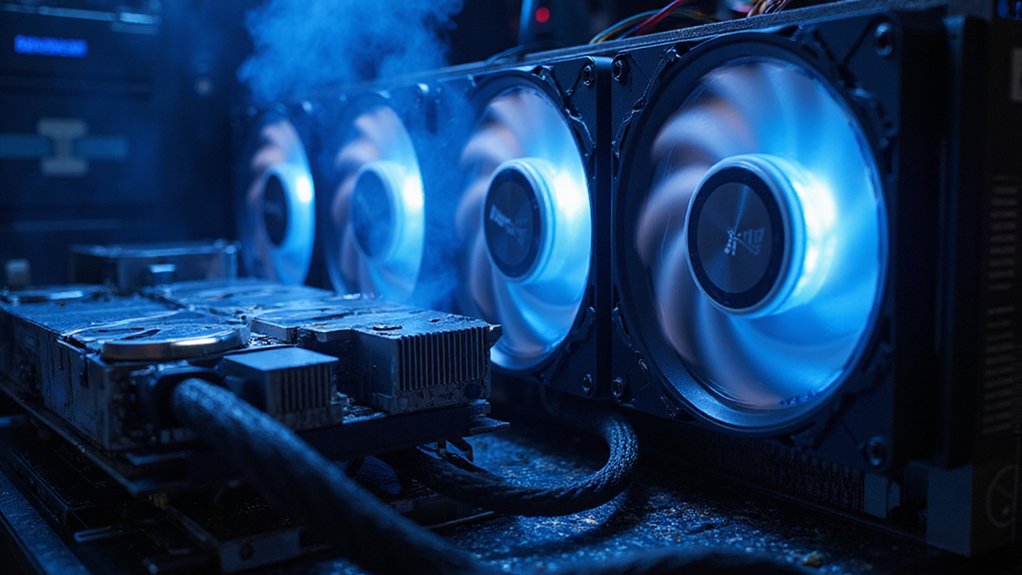Blockchain nodes constitute the essential infrastructure of decentralized networks, functioning as vigilant gatekeepers that receive, verify, and transmit transactional data. These distributed sentinels—whether full nodes storing complete ledgers or lightweight alternatives using Simplified Payment Verification—collectively guarantee network integrity without centralized control. By participating in consensus mechanisms, nodes create mathematical certainty for transactions while establishing formidable resistance against manipulation. The computational demands may seem steep, but this distributed architecture delivers blockchain’s most revolutionary promise: a transparent system impervious to the whims of singular authorities. The rabbit hole goes much deeper.

How exactly does a blockchain function without a central authority?
The answer lies in blockchain nodes—computer systems forming the backbone of these distributed networks.
These technological sentinels receive, verify, store, and transmit data across the blockchain.
They collectively maintain the network’s integrity while ensuring no single entity controls the system (a rather innovative departure from traditional financial infrastructures).
Nodes come in several varieties, each serving distinct functions within the ecosystem.
Full nodes maintain complete copies of the blockchain ledger, while lightweight nodes employ Simplified Payment Verification to confirm transactions without storing the entire chain—a practical solution for devices with limited storage capacity.
Validator nodes, perhaps the network’s most industrious participants, verify transactions and add new blocks through consensus mechanisms, while authority nodes govern network access in partially decentralized systems.
The significance of these nodes extends far beyond mere data management.
Nodes embody the architectural backbone enabling truly decentralized systems to operate with unprecedented resilience and transparency.
They represent the foundational architecture that enables truly decentralized systems to operate with remarkable resilience.
By distributing validation processes across numerous independent nodes, blockchain networks create a robust security mechanism resistant to manipulation—no small feat in an era of sophisticated cyber threats.¹
Running a node is not without its technical demands.
Significant computational resources, compatible software, continuous internet connectivity, and substantial storage capacity are prerequisites for node operators.
Full archival nodes, which preserve historical states of the blockchain, require particularly extensive storage capabilities—commitment indeed for the blockchain purist.
The distribution of nodes across global networks creates an inherently attack-resistant system.
Should malicious actors compromise certain nodes, countless others stand ready to maintain consensus and preserve data integrity.
This fundamental characteristic enables blockchain technology to support financial systems where participants need not blindly trust centralized authorities but can instead rely on mathematical certainty and distributed validation—a prospect that traditional financial institutions might find simultaneously fascinating and unsettling.
Master nodes perform critical governing functions while also helping validate transactions, making them essential components in proof-of-stake consensus systems that require staked funds as collateral.
In Proof of Stake networks, validator nodes are often selected based on the amount of crypto tokens they have locked up in the system, providing both security and token holder rewards.
Lightning nodes create efficient payment channels that allow users to conduct off-chain transactions without congesting the main network.
¹This distributed security model represents one of blockchain’s most consequential innovations.
Frequently Asked Questions
How Much Does It Cost to Run a Blockchain Node?
The cost of running a blockchain node varies considerably, ranging from $50 monthly for light nodes to several thousand dollars for full validator setups.
Expenses include hardware ($500-$5,000+), electricity ($30-$200 monthly), bandwidth costs, and maintenance.
Archive nodes, with their hefty storage requirements, naturally command premium operational expenses.
Node operators must weigh these financial commitments against potential revenue streams—staking rewards being the obvious, if inconsistent, counterbalance to the ledger’s persistent drain.
Can I Run a Node on My Home Computer?
Yes, running a node on a home computer is feasible, provided the machine meets baseline requirements.
The task demands a modern multicore processor, 16+ GB RAM, and 1-2 TB of SSD/NVMe storage (given Bitcoin’s 100 GB annual growth).
A stable internet connection with substantial bandwidth (5-10 TB monthly) is non-negotiable.
While technically possible, one shouldn’t underestimate the commitment—24/7 operation, regular updates, and eventual hardware upgrades form the less glamorous reality of node maintenance.
Do Nodes Get Financial Rewards Like Miners?
Unlike miners, most blockchain nodes don’t receive direct financial compensation for their validation work—a curious economic asymmetry in decentralized networks.
However, the landscape isn’t uniformly barren; certain consensus mechanisms (notably Proof-of-Stake) do reward participating nodes with crypto assets.
Mining nodes, a specialized subset, earn block rewards and transaction fees for their computational heavy lifting.
The majority of nodes, though, operate for network participation benefits rather than immediate monetary gain.
How Much Technical Knowledge Is Needed to Maintain a Node?
Maintaining a blockchain node requires substantial technical expertise across multiple domains.
System administration skills (particularly Linux proficiency), networking fundamentals, and storage management form the baseline requirements.
Operators must navigate regular software updates, security patches, and troubleshooting protocols—all while monitoring resource utilization as blockchains inevitably expand.
While user-friendly interfaces have somewhat democratized node operation, the underlying complexities remain; without technical aptitude, node operators risk compromising network integrity and potentially their own security posture.
What Happens if a Significant Percentage of Nodes Go Offline?
When a significant percentage of nodes go offline, blockchain networks typically demonstrate remarkable resilience.
The decentralized architecture guarantees continued functionality, though not without consequences.
Remaining nodes shoulder increased computational burdens, potentially causing transaction delays and congestion (the digital equivalent of rush-hour traffic, but with cryptographic verification instead of honking).
Security vulnerabilities may emerge as validation resources thin out, making the network theoretically more susceptible to attacks—though redundancy mechanisms generally prevent catastrophic failure unless truly overwhelming numbers go dark simultaneously.









